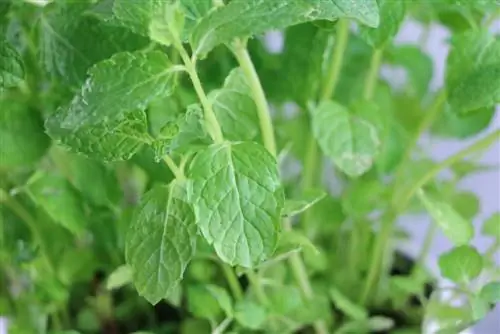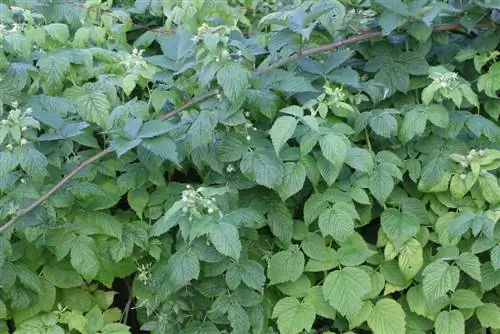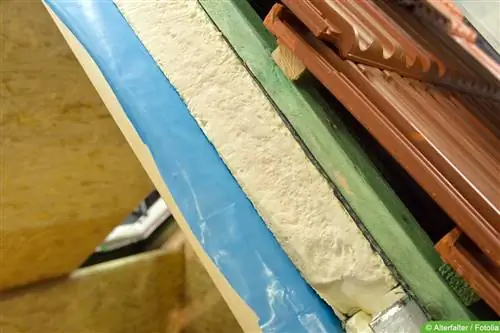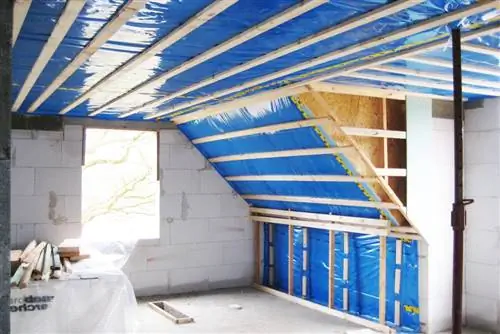- Author admin [email protected].
- Public 2023-12-17 03:39.
- Last modified 2025-01-24 12:45.
There are many plants, such as the popular bamboo, that reproduce underground through the so-called rhizomes. This happens very quickly and if these meandering roots are not stopped, the plants can grow unhindered anywhere in your own garden and even into your neighbor's garden. A rhizome barrier that is inserted into the soil around the plant when it is first planted helps against this. These barriers are available to buy ready-made in stores, but if you want to build it yourself, you can find the instructions here.
Rhizome Barrier Definition
Different plant species also have different roots. There are shallow-rooted plants, deep-rooted plants and plants such as bamboo, which is popular in the garden, and which have rhizomes. If these rhizomes are not prevented from spreading, the plants will grow out of the ground throughout the entire garden and even in the neighboring garden. A barrier is needed so that the sprouts from which the new plants grow cannot spread everywhere underground. This must also limit the area underground in which the plant can spread. The rhizome barrier must be so tight that no sprouts can penetrate through it. These usually look like this:
- made of durable plastic
- Polyethylene (HDPE)
- Polypropylene (PP)
- are available in roll form
- plastic or metal tubs are also suitable for smaller boundaries
- An old plastic rain barrel can also be used for small beds
- Pond liner, roofing felt or other tarpaulins are only suitable to a limited extent
- only recommended for lighter rhizomes
- Bamboo rhizomes can bore through
Features
In order for the selected rhizome barrier to achieve the desired effect, it must fulfill certain purposes. Therefore, you should always think about the size of the desired area and the strength of the shoots in advance. In addition, the rhizome barrier used should have the following properties, otherwise the strength could be affected:
- Parts above ground must not be affected by the sun
- Frost must not cause brittleness
- it must be resistant to rodents
- it must not release any pollutants into the earth
Tip:
Just putting a plastic wrap around the plant in the ground doesn't have the desired effect. The hobby gardener should therefore seek good advice from retailers before purchasing the barrier, even if the purchase could involve a few more costs.
Plants with rhizomes

It is clear to every hobby gardener that bamboo will spread unhindered in the garden if left unchecked. But there are many other plants that also find their way underground via the rhizomes and then begin to sprout again from these sprouts in a completely different place in the garden or even at the neighbor's house. It only takes a short time and the entire garden can be conquered; in such a case, other plants often have no chance of surviving. But which plants have rhizomes that should be contained by a barrier immediately upon planting. Some of the specimens are presented here:
- Raspberry bushes are also rhizomatous plants
- Shallow roots, but still install barrier to a depth of 40 cm
- new popular plant sea buckthorn
- A depth of 60 cm should be planned here
- often popular in the garden, the vinegar tree
- Roots not as strong as bamboo
- one thickness of pond liner is sufficient as a barrier
- If mint is not stopped, it will conquer the entire garden
- Ideally cultivate in a container
Of course there are many more plants that need a root barrier. Ideally, when purchasing from a good gardening store, the seller will be asked directly whether the plant reproduces underground via rhizomes. If this is the case, you should not forget to use the barrier directly when planting, even if this means more work at first. Otherwise, proliferation can be poorly controlled and sustainable removal can usually only be carried out by specialists.
Tools required
Before installation, the required tools and materials should be collected. Depending on which plant the barrier is needed for, the thickness of the films used must be selected. A small excavator, which can be rented from a specialist retailer, should be available for installation. Digging out a bed that can be a good twelve square meters with a spade and a shovel to a required depth of 65 cm involves a lot of work and effort. Bamboo plants in particular have to be excavated very deeply so that the rhizomes do not find a way under the built-in barrier. Additional tools are required as follows:
- Cordless screwdriver
- small drill
- for screwing the locking rail
- alternatively foil welding device or hot air dryer
Select location
Now the location for the plant is chosen. A bamboo, for example, should have at least an area of three square meters in which it can spread, although a larger bed is more ideal. The border is cut off with a spade and the entire circumference can then be measured. Accordingly, the rhizome barrier is then purchased commercially in the specific length required. It is important that the barrier seals well at the seam so that no roots can fit through. Once the location has been chosen and the material has been procured, installation can begin.
Install

Ideally, for large areas, a small excavator is rented with which the bed can be excavated. Then the work gets done quicker. These excavators can be rented by the hour or day. This makes it a little more expensive, but if a large bed needs to be excavated by around 60 centimeters, this cannot be done so quickly with a spade. When installing, you should then proceed as follows:
- Cut plastic film to desired length
- drill holes for the aluminum rail in both ends
- work carefully, holes must be at the same height
- Insert foil around the bed
- About five to ten centimeters should stick out of the soil later
- this prevents roots from growing over the barrier
- place the barrier at a slight angle in the upper area
- so the roots don't grow downwards, but rather upwards
- attach the ends with an aluminum rail to the holes with screws
- alternatively close with a foil sealer or hot air dryer
If the film is attached around the bed from the inside, some of the earth is filled in again along the barrier so that it is secured. Then the desired plants can be inserted and the remaining soil can be filled in again.
Tip:
If you want to install a rhizome barrier made of durable plastic, you should get another person to help you, because it can be quite difficult to unwind the hard film from the roll and sink it into the ground around the bed so that even no roots can find a way. And when fastening the seam later, four hands are more helpful than just two.
Lock from tub or barrel
For small beds that are to be created, for example for a single raspberry bush or a mint plant, you can alternatively choose a tray made of plastic or metal, and an old rain barrel cut to the desired height can also be used. The procedure is as follows:
- Dig the bed according to the size of the tray to be used
- Removing the floor from the tub or rain barrel
- alternatively, drill holes to allow the irrigation water to drain away
- then insert into the bed
- about five to ten centimeters should be above the ground
- Partially fill in soil
- insert desired plants
- fill remaining soil
Tip:
These tubs are suitable for small beds because the walls are very solid and the roots cannot find a way down. There is also no way for the rhizomes to get through any seam, as the tray is inserted seamlessly.
Rhizome barrier made of pond liner etc
Pond liner can also be used to a limited extent, although it can only be used on plants with weaker rhizome formation, otherwise the thinner liner can quickly be broken through. This film is also usually not strong enough to provide sufficient protection against roots growing upwards from the ground. Roofing felt is not always a good choice either. But these materials are often used if they are still in the shed and left over from other work. If bamboo is planted, these materials should not be used. However, this can put a stop to the raspberries or sea buckthorn. However, if you want to be on the safe side, install a barrier made of solid plastic materials.
Tip:
Especially when bamboo is planted on a pond bank, it is always advisable to surround it with a barrier made of solid plastic, as the pond liner is in no way sufficient to stop the increased growth to the outside.
Install later
Of course, rhizome barriers can also be used subsequently if this was neglected during planting or if the garden has already been taken over in this form. If the root runners are already everywhere in the garden, this can be recognized by the fact that the corresponding plants are sprouting from the ground everywhere. These must then be removed as quickly as possible. Likewise, all root runners from the mother plant to the daughter plants must be cut off and ideally completely removed from the soil. This can be particularly difficult with bamboo because it has very strong roots that cannot be easily cut. Then you might need a saw or an ax. When setting the block, the procedure is as follows:
- dig a gap about 60 cm deep around the plant
- put the lock here
- let it look upwards by about five to ten centimeters
- bend the top edge a little inwards
- close with aluminum rail
- Fill soil back into the gap
Over the next few months you should always keep an eye out for any sprouting seedlings outside the bed. Because it is always possible that not all roots have been removed. The daughter plants may also have already formed their own rhizomes outside the bed, which allow further new plants to emerge.
Conclusion
Anyone who brings new plants into the garden should find out in advance whether these rhizomes form underground runners from which new plants can then form from the soil anywhere in the garden. When it comes to bamboo, most hobby gardeners know that it needs a rhizome barrier, but many other plants, such as the tasty raspberries or mint, are forgotten here. Installation is easy if the instructions are followed and should definitely be carried out when planting for the first time. Although it is not impossible, it is certainly more difficult if the barrier has to be installed later in order to limit the damage that has already occurred. Ideally, a robust plastic film is always used for the barrier. When working with materials such as pond liner or roofing felt, this is never a 100% guarantee that the plant cannot spread, as this is material that some rhizomes can easily break through. Alternatively, for small beds, tubs made of plastic or metal or old rain barrels can be used, which also offer sufficient protection.






